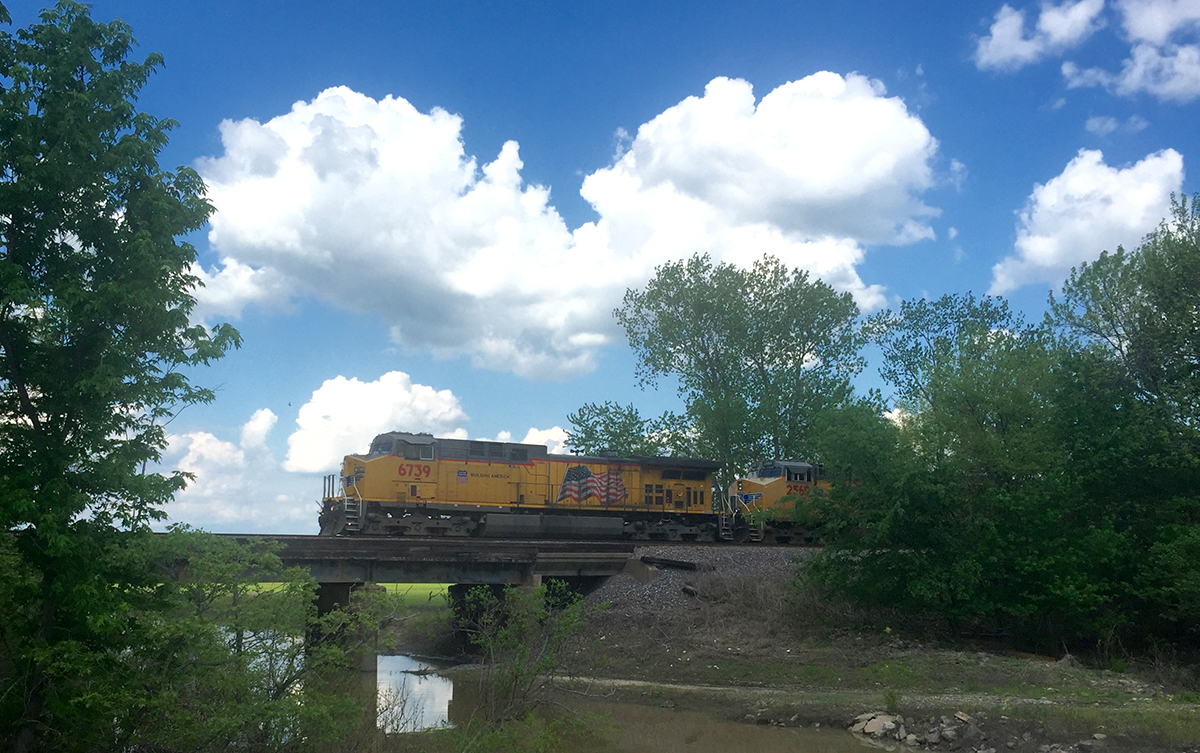
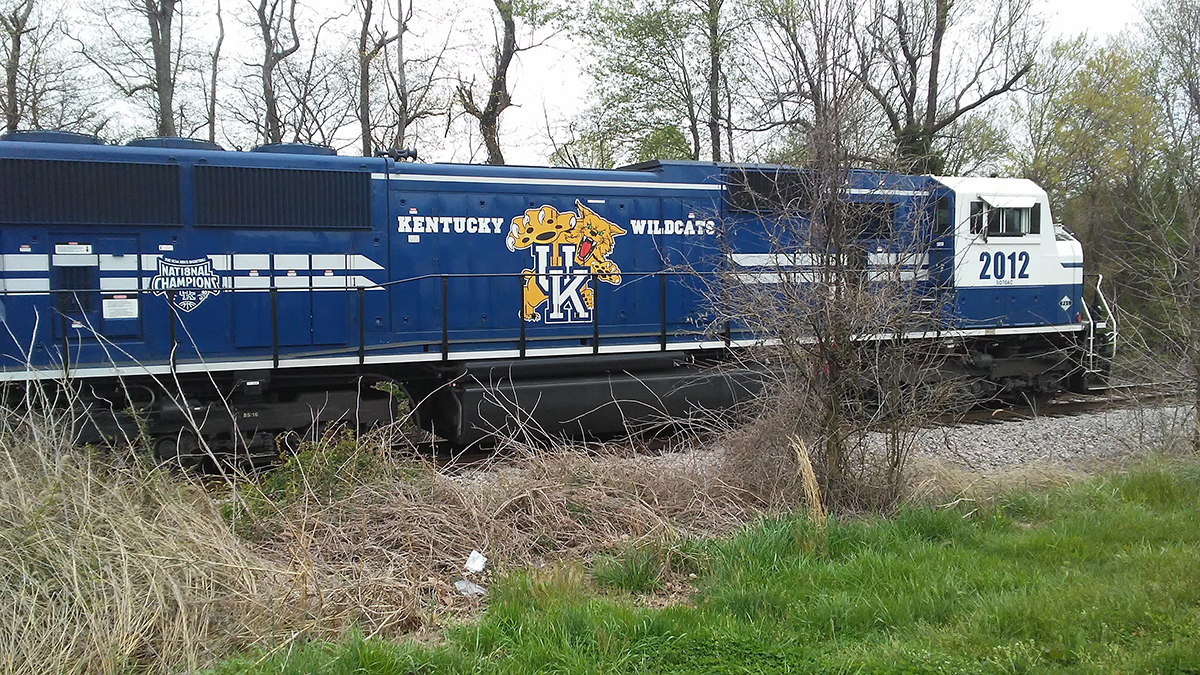
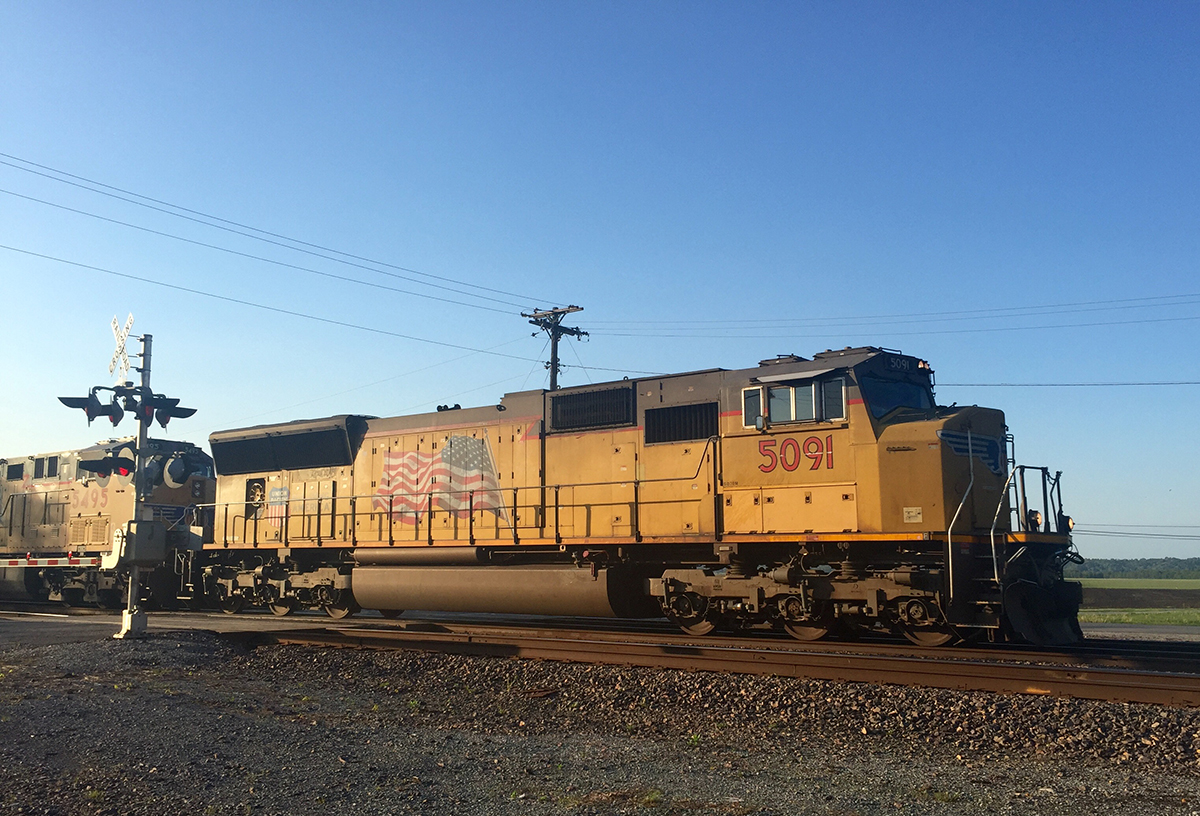








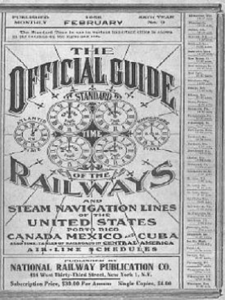 “The Official Guide was the primary reference used by ticket agents for all railroads in the U.S. and Canada, and for international rail travel to Mexico. The Guide was especially useful for constructing connections among the many railroads of the time. The Official Guide, published monthly, also included some high priority freight schedules, system maps, listing of company officers, an index of all railroad stations, industry news briefs and personnel changes, rosters of key railroad officials, and new passenger train announcements, along with steamship schedules. Ticket-sellers like the one in the story below relied on the Guide, a large book a couple inches thick. You’ll soon see why.”
“The Official Guide was the primary reference used by ticket agents for all railroads in the U.S. and Canada, and for international rail travel to Mexico. The Guide was especially useful for constructing connections among the many railroads of the time. The Official Guide, published monthly, also included some high priority freight schedules, system maps, listing of company officers, an index of all railroad stations, industry news briefs and personnel changes, rosters of key railroad officials, and new passenger train announcements, along with steamship schedules. Ticket-sellers like the one in the story below relied on the Guide, a large book a couple inches thick. You’ll soon see why.”
“I’d like a one-way ticket to Davis, please.” The prospective passenger at the Chicago Union Station thought that his request was reasonable enough and quite clear, so he wasn’t prepared for the somewhat agonized look on the ticket-sellers face. “Davis? I’m sorry, sir, but you’ll have to be more specific. There are 18 railway stations names Davis in the United States.” “Really? Well, I want to go to Davis, Illinois.” The ticket clerk sighed deeply. “I’m sorry to trouble you again, sir, but there are four railway stations names Davis in Illinois.”
It was the passenger’s turn to look puzzled, but he came through bravely. “I want the Davis, Illinois, on the Gulf, Mobile & Ohio. Is that sufficiently clear?”
“In a way, sir, it is,” the ticket clerk answered wearily. “You see, there are two Davises in Illinois on the GM&O. One of them is in Alexander County and the other is in Morgan County.”
This is of course, a somewhat exaggerated situation, but what if the passenger had wanted to go to Summit! Wherever there was a grade of any magnitude, the officers of the railroad called the station at the top: Summit. There were 71 different railway stations names Summit in the U.S., Canada, Mexico and the Canal Zone. The photo is the complete story by Charles Layng as published in TRAINS Magazine of May 1952, nearing the end of the heyday of rail travel. A good read. (You may need to creatively enlarge the attachment)
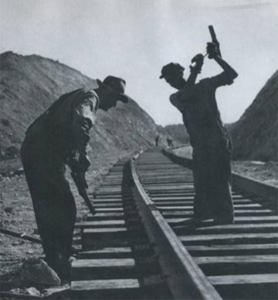 Way back when, few insurance companies would write policies for railroaders — their jobs were considered too risky. Early in the 20th Century (and before the various “Safety First” campaigns that we still see today), a dozen railroaders – on average — died on the job each day. On any given day, tens or hundreds more were injured or maimed.
Way back when, few insurance companies would write policies for railroaders — their jobs were considered too risky. Early in the 20th Century (and before the various “Safety First” campaigns that we still see today), a dozen railroaders – on average — died on the job each day. On any given day, tens or hundreds more were injured or maimed.
So railroaders set up their own group insurance plans and mutual benefit associations. The idea of a pension was not new. But an industrial pension program so that employees could expect to retire (rather than work until they died) was largely a railroad innovation. The first plans emerged in the early 1880s and led to the creation of the Railroad Retirement Board in 1934, which was the model for the Social Security Act a year later.
Credits: Pix and text from Working on the Railroad, Kalmbach 2011 – Submitted by Gary Ostlund

 Kathy and I celebrated our 18th anniversary the weekend of April 8 by going to Bardstown KY and a ride on “My Old Kentucky Dinner Train” for the noon meal trip on April 7.
Kathy and I celebrated our 18th anniversary the weekend of April 8 by going to Bardstown KY and a ride on “My Old Kentucky Dinner Train” for the noon meal trip on April 7.
Our trip started out with snow and icy roads. My drive to Bardstown from Mortons Gap was, at times, white knuckle! Once we arrived and redeemed our vouchers, I walked around the old ex-L&N depot, looked over the model trains on display, took in the many prints on the wall and admired the remaining antique scale.
Once on board the train and seated in car number 003, we chatted with our table mates Tyrell and NaTosha. No, I am not making this up! This newly wed couple had never ridden a train and seem to enjoy the event. Tyrell and I had some common ground and interests. 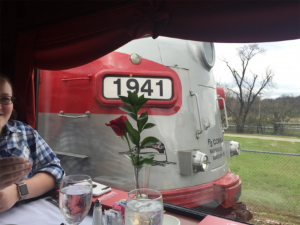
The ride was nice. The track was surprisingly uneven for RJ Corman Railroad standards. But slow speed made the ride “real”! Kathy had a first time experience of walking on a moving train and laughed the whole time! The aforementioned snow made the view outside our window most pleasant.
On the return trip we were having dessert when I felt the generator change tone, vibrate…(l looked at Tyrell and he had the same look on his face I did. His experience as a mechanic told him what I felt to be as well) then…it died. Out went the lights, the AC and the noise was…no noise!
Even though it was about 38 degrees outside by this time, with 60 plus people in our car it began to heat up quickly! Our train came to a stop, crew members arrived outside our window with tools. With in minutes we were on our way with lights and AC….and generator noise!
A high light for me was seeing the RJ Corman Railroad EMD F units run around our train at each end of the run.
The trip back was over in a flash it seamed. We left out passenger car for the open road…well, hi-ways 150 and 68 to Wilmore KY. and the Potters Inn B&B.
As for the meal…we ordered the Kentucky Hot Brown. Now, I grew up with Mom and Kathy’s KY Hot Brown served with brown gravy! I did not know the traditional KY Hot Brown has creamy cheesy… stuff on it! The quality was excellent. I did not like the meal which is no reflection on the cook or the train. The Apple Dumpling though…beyond good!
I doubt I will do the dinner train again unless for a really special occasion. I do however recommend same for anyone whom enjoys trains.
So the question becomes, “why paint up a fancy new locomotive and leave the wheels and coupler all rusty..?” Very simply put, the wheels and couplers take a horrendous beating. Hairline cracks occasionally form, and if painted are difficult to detect. Broken couplers and chipped wheels cause nasty derailments. Rail managers feel that a little rust isn’t going to hurt anything, and maintenance forces can easily stay ahead of the problems. Submitted by Gary Ostlund.
Former chapter member Fred Ripley sent me this for my birthday back in April! Great present. Bill
Louisville & Nashville 4-8-2 No. 407 on Cincinnati–Birmingham train 7 passes 2-8-0 No. 1212 on a northbound freight on double track 10 miles south of Louisville in November 1948. – C. William Streit photo
At 70 miles per hour, this Kansas City bound Piggybacker will disappear across the Oklahoma prairie as quickly as the sky darkens in the vivid sunset. You probably have never heard of Avard, but to a railfan, this is a “hot spot.” This line in northwestern Oklahoma was the Santa Fe mainline. Now as the Burlington Northern Santa Fe’s “Transcon,” these rails see more action than ever, over a hundred trains a day. Gary Ostlund